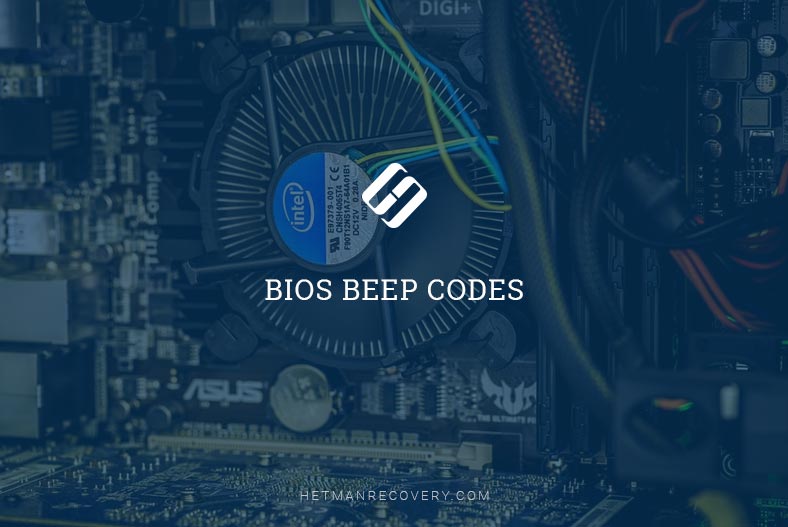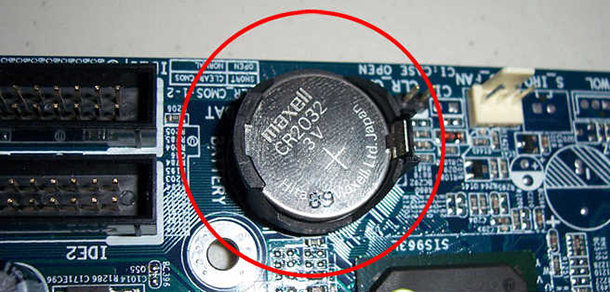Usb Fans Read Messages Piece of Junk
BIOS Beep Codes for Troubleshooting
In this article, we collected the almost widespread BIOS signals (beepcodes) used for troubleshooting in case of any PC issues. Withal if your computer gives a sound signal which is not listed below, consult the motherboard / PC user manual to identify what kind of hardware error information technology is.

The POST (ability-on self-test) feature checks the computer's internal hardware to ensure compatibility and connection before the actual kicking occurs. If the computer boots properly, it may requite one audio signal (some computers are supposed to give it twice) equally it starts and continues to kick. Still, if the computer breaks down, it will either give no bespeak at all or give a special bespeak indicating a certain trouble.
AMI BIOS signals
AMI BIOS signals (or beep codes) are given below. Withal, beep codes may differ due to a big variety of manufacturers who produce computers with this type of BIOS.
Sound signal (beep code) — Description
- one short beep No errors detected, normal kick
- 2 curt beeps Parity circuit failure
- 3 shot beeps Base 64 Chiliad RAM failure (The first 64 KB of RAM are out of order)
- four brusque beeps System timer failure
- v short beeps Procedure failure
- 6 curt beeps Keyboard controller Gate A20 error
- 7 short beeps Virtual manner exception error (System lath issue)
- 8 short beeps Display memory Read/Write test failure (VRAM error)
- nine short beeps ROM BIOS checksum failure
- 10 short beeps CMOS shutdown Read/Write fault
- 11 short beeps Enshroud Memory error
- 1 long beep, 3 short beeps Conventional/Extended memory failure (Graphics card is out of lodge)
- ane long beep, 8 brusque beeps Display/Retrace test failed
- Two-tone siren Low CPU Fan speed, Voltage Level issue.
Accolade BIOS signals
Below, we listed AWARD BIOS signals (beep codes). As well as in the previous instance, beep codes may differ due to a big variety of manufacturers who produce computers with this type of BIOS.
Audio signal (beep lawmaking) Description
- 1 long beep, ii short beeps — Indicates a video error has occurred and the BIOS cannot initialize the video screen to display any additional information. (Graphics card non establish, or VRAM error)
- 1 long beep, three short beeps — Video card not detected (reseat video card) or bad video bill of fare (Depending on the BIOS version, this beep code may indicate either a graphics card error or a keyboard error)
- Incessantly repeated signal — RAM problem.
- Repeated frequent beeps while the estimator is working — Overheating processor (CPU)
- Repeated beeps, frequent and seldom — Result with the processor (CPU), possibly damaged
If there are any other hardware problems, BIOS will show you a corresponding message.
Dell signals
Audio bespeak (beep lawmaking) — Description
- 1 beep — BIOS ROM corruption or failure
- ii beep — Memory (RAM) not detected
- three beep — Motherboard failure
- 4 beep — Memory (RAM) failure
- 5 beep — CMOS Battery failure
- 6 beep — Video card failure
- seven beep — Bad processor (CPU
IBM BIOS signals
At present, here are some IBM BIOS signals.
Sound signal (beep lawmaking) — Description
- None — No Power, Loose Carte du jour, or Short (Power supply unit, motherboard or internal speaker is out of social club)
- 1 short beep — Normal POST, computer is ok. (No errors detected)
- 2 short beeps — POST error, review screen for error code.
- Continuous beeps — No Power, Loose Card, or Short. (No ability supply)
- Repeated brusque beep — No Ability, Loose Card, or Short. (No power supply)
- 1 long beep, 1 short beep — Motherboard issue.
- 1 long beep, 2 short beeps — Video (Mono/CGA Display Circuitry) event.
- 1 long beep, 3 curt beeps — Video (EGA) Brandish Circuitry.
- three long beeps — Keyboard or Keyboard card fault.
- ane beep and black screen — Video Display Circuitry. (The monitor doesn't work)
Phoenix BIOS signals
Below, we listed Phoenix BIOS Q3.07 OR 4.Ten signals (beep codes).
Audio point (beep code) Description
- i-i-one-i Unconfirmed beep code. Reseat RAM chips or supercede RAM chips every bit possible solution
- ane-i-1-3 Verify Real Manner.
- 1-1-ii-1 Go CPU Type.
- 1-1-2-3 Initialize system hardware.
- 1-ane-3-one Initialize chipset registers with initial Post values.
- 1-one-iii-two Set in Post flag.
- one-1-iii-3 Initialize CPU registers.
- 1-1-4-ane Initialize cache to initial POST values.
- 1-1-4-iii Initialize I/O.
- one-2-1-1 Initialize Power Direction.
- 1-2-1-ii Load alternate registers with initial Mail service values.
- 1-2-i-3 Jump to UserPatch0.
- 1-ii-two-i Initialize keyboard controller.
- 1-2-2-3 BIOS ROM checksum.
- 1-ii-3-1 8254 timer initialization.
- 1-2-3-3 8237 DMA controller initialization.
- 1-2-4-1 Reset Programmable Interrupt Controller.
- i-iii-one-1 Test DRAM refresh.
- 1-3-1-3 Test 8742 Keyboard Controller.
- one-iii-2-1 Prepare ES segment to register to iv GB.
- 1-3-iii-1 28 Autosize DRAM.
- one-3-3-three Clear 512 K base RAM.
- ane-three-4-1 Exam 512 base address lines.
- 1-3-4-3 Test 512 K base memory
- i-4-i-3 Test CPU bus-clock frequency.
- one-4-2-4 Reinitialize the chipset.
- ane-iv-3-1 Shadow system BIOS ROM.
- i-iv-3-2 Reinitialize the cache.
- 1-4-3-3 Autosize cache.
- ane-4-4-1 Configure advanced chipset registers.
- 1-4-4-2 Load alternating registers with CMOS values.
- 2-one-1-ane Set Initial CPU speed.
- 2-1-i-3 Initialize interrupt vectors.
- 2-1-ii-1 Initialize BIOS interrupts.
- 2-1-ii-3 Bank check ROM Copyright find.
- 2-one-2-4 Initialize manager for PCI Options ROMs.
- 2-1-3-1 Check video configuration against CMOS.
- two-ane-three-ii Initialize PCI bus and devices.
- two-one-3-3 Initialize all video adapters in arrangement.
- ii-1-four-one Shadow video BIOS ROM.
- ii-one-4-3 Display Copyright notice.
- 2-2-1-1 Display CPU Type and speed.
- 2-2-1-3 Examination keyboard.
- two-2-two-1 Set key click if enabled.
- two-2-2-3 56 Enable keyboard.
- ii-two-3-1 Test for unexpected interrupts.
- 2-2-3-3 Display prompt Press F2 to enter SETUP.
- 2-two-iv-one Test RAM between 512 and 640 k.
- ii-3-ane-1 Examination expanded memory.
- 2-three-1-3 Test extended memory address lines. (Test extended retentiveness address lines).
- 2-iii-ii-1 Jump to UserPatch1. (Bound to UserPatch1).
- two-3-2-3 Configure avant-garde cache registers.
- 2-3-3-1 Enable external and CPU caches.
- ii-3-3-3 Display external enshroud size
- 2-3-4-1 Display shadow bulletin.
- 2-three-iv-3 Display non-dispensable segments.
- 2-4-1-one Brandish fault messages.
- ii-iv-i-3 Check for configuration errors.
- 2-iv-two-1 Test existent-time clock.
- ii-4-2-three Check for keyboard errors
- 2-4-4-i Fix hardware interrupts vectors.
- ii-4-4-3 Test coprocessor if nowadays.
- 3-1-i-i Disable onboard I/O ports.
- 3-1-1-3 Find and install external RS232 ports.
- three-1-ii-1 Detect and install external parallel ports.
- 3-one-ii-three Re-initialize onboard I/O ports.
- iii-1-3-one Initialize BIOS Data Area.
- three-ane-3-3 Initialize Extended BIOS Data Area.
- 3-i-4-ane Initialize floppy controller.
- 3-ii-one-1 Initialize hard disk controller.
- 3-two-one-2 Initialize local double-decker hd controller.
- 3-2-one-3 Jump to UserPatch2
- 3-two-two-1 Disable A20 address line.
- iii-two-ii-3 Clear huge ES segment register.
- 3-2-3-one Search for choice ROMs.
- 3-ii-3-iii Shadow option ROMs.
- three-2-four-one Set upwardly Power Management.
- 3-2-iv-3 Enable hardware interrupts.
- 3-3-ane-1 Set time of day.
- 3-three-ane-3 Check fundamental lock.
- 3-three-three-1 Erase F2 prompt.
- 3-3-3-3 Browse for F2 key stroke.
- 3-3-4-1 Enter SETUP.
- three-3-4-3 Clear in POST flag.
- 3-4-i-1 Erase F2 prompt.
- 3-4-one-3 Mail service done, set up to kick operating organisation.
- 3-4-2-iii Bank check password (optional).
- iii-4-3-1 Articulate global descriptor table.
- 3-4-iv-1 Clear parity checkers.
- 3-four-4-3 Clear screen (optional).
- 3-4-4-4 Check virus and backup reminders.
- four-1-1-ane Try to boot with INT 19.
- four-2-1-1 Interrupt handler fault.
- four-2-1-3 Unknown interrupt mistake.
- four-2-2-1 Pending interrupt error.
- 4-ii-two-3 Initialize option ROM error.
- 4-2-3-1 Shutdown error.
- 4-ii-3-3 Extended Block Movement.
- 4-ii-4-1 Shutdown 10 fault.
- iv-3-1-3 Initialize the chipset.
- four-iii-1-four Initialize refresh counter.
- 4-three-2-1 Check for Forced Flash.
- 4-three-2-2 Check HW condition of ROM.
- iv-3-2-three BIOS ROM is OK.
- 4-three-ii-4 Do a complete RAM test.
- four-three-3-1 Do OEM initialization.
- four-3-iii-2 Initialize interrupt controller.
- 4-3-3-3 Read in bootstrap code.
- 4-3-iii-4 Initialize all vectors.
- iv-3-4-i Kick the Flash program.
- 4-3-4-2 Initialize the boot device.
- four-iii-4-3 Kicking code was read OK.
Resetting BIOS to default settings
The easiest way to reset BIOS is from its menu. To access this menu, restart the estimator and press the dedicated key that appears on the screen when the computer is booting; in virtually cases, it'south either Delete or F2.

When in BIOS, wait for a setting with the name like Reset to default, Load manufacturing plant defaults, Clear BIOS settings, Load setup defaults. Use arrow keys to select information technology, and press the Enter key to ostend this action. At present BIOS volition use default settings.

One more way to reset BIOs is to have out the battery located on the computer'south motherboard.

Offset of all, make sure the computer is powered off. Find a circular flat battery on the motherboard and remove it carefully. Place information technology dorsum after five minutes. This simple activeness will reset BIOS settings to default.
Installing new hardware
Sometimes, BIOS has to exist updated and then that it can back up a piece of new hardware, for instance, a more powerful CPU. You tin see how it is done by watching a video in our YouTube aqueduct.
See the full article with all additional video tutorials.
Source: https://habr.com/en/company/hetmansoftware/blog/548204/
0 Response to "Usb Fans Read Messages Piece of Junk"
Post a Comment